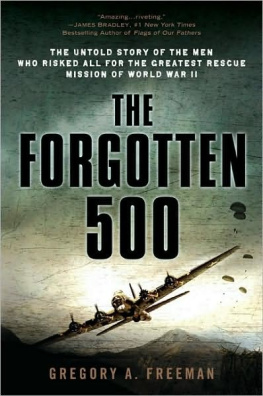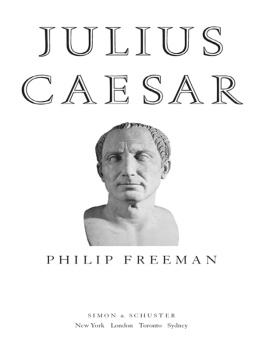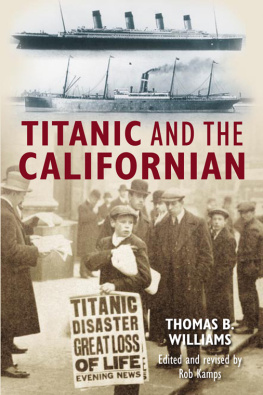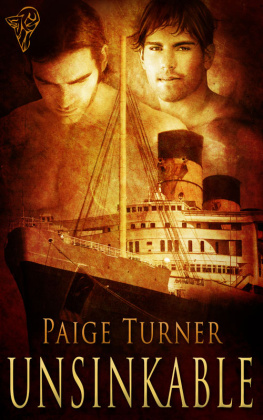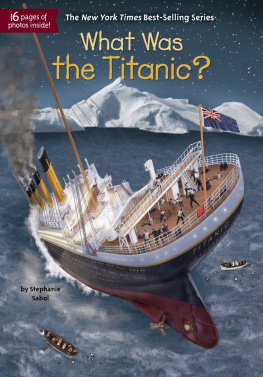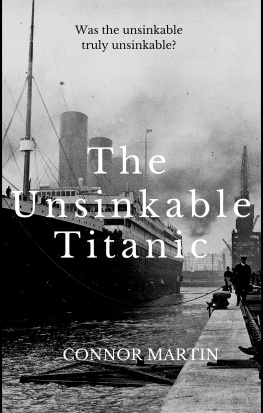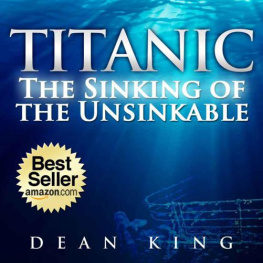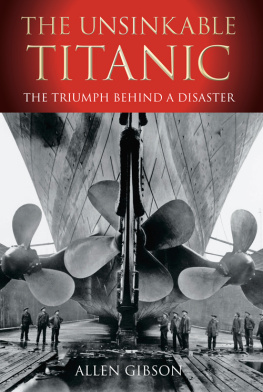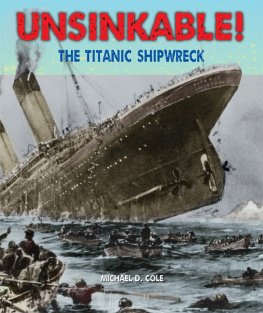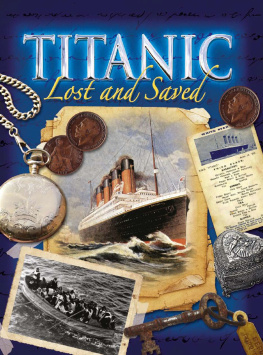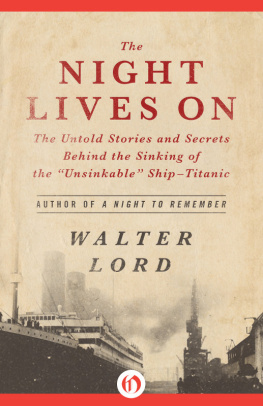The RMS 1
Titanic struck an iceberg on the night of April fourteenth 1912, and sank in the North Atlantic waters in the wee hours of the following morning. She took more than 1,500 souls with her. While this death toll is devastating, it is by no means the greatest at-sea catastrophe in western history. Even besides wartime disasters, the explosion of the Mont-Blanc in Nova Scotia killed almost two thousand in 1917, the 1707 Sicily Naval Disaster killed almost the same number of people, and several other shipwrecks with smaller death tolls were arguably more dramatic. Yet fascination with the Titanic has persisted since she rested on the ocean floor, long before James Camerons 1997 blockbuster film. Why?
In many ways, the sinking of the Titanic can be seen as the perfect, tragic end to an era of seemingly boundless technological innovation as well as decadent lifestyles built on vast inequalities of wealth. As has been popularly remembered, many people believed that God himself cannot sink this ship (although the ships builders never went so far as to make that claim). People truly believed that the technological innovations surrounding shipbuilding and other industries had made the Titanic invincible. When she did sink, on her maiden voyage, this confidence in human innovation was shaken. Ensuing investigations would search for an explanation that would allow them to reassert their confidence, but in the end they came up empty-handed. Barely two years later, this shaken confidence in human progress would be shattered as Europe and the world plunged into World War I, which saw unprecedented death (the death toll is estimated at seventeen million) and destruction at the hands of new wartime technologies.
Several prominent businessmen robber barons went down with the ship as well, including John Jacob Astor IV and Benjamin Guggenheim. The years that followed would also see a challenge to their kind of entrenched wealth and power: when World War I ended, labor riots erupted in countries around the world. While labor unrest had been fomenting for decades, the riots of 1919 were especially violent and the fear of communism swept the western world. In addition, a virulent influenza epidemic spread globally in 1918-1919, killing a staggering twenty to forty million people. Perhaps these factors help explain our collective fascination with the Titanic disaster: it occurred at a time that allows it to symbolize the end of an era of wealthy, gallant gentlemen; faith in technological progress; and a sense of optimism about the future. Regardless, the story of the Titanic is an enthralling tale, from its conception, to its demise, to its re-discovery decades later.
1
RMS stands for Royal Mail Ship, which simply means that the ship carried mail for the British governments mail service.
Chapter One
Conceiving of and Building the Titanic
The Titanic was built by the White Star Line, a British shipping company controlled by the International Mercantile Marine Company. The idea for the ship was broached first in 1907 when the White Star Line faced stiff competition in the passenger ship market. Their main competitors were the German-owned Hamburg America line and the British-owned Cunard line (which merged with the White Star Line in 1934 and now operates Carnival Cruise Line). Cunard had recently launched two new remarkable ships that made trans-Atlantic voyages, the RMS Mauritania and the RMS Lusitania (which also sank in 1915). Both were primarily known for their speed, so J.P. Morgan, the infamous American banker who owned controlling shares in the International Mercantile Marine Company, and J. Bruce Ismay, the head of the White Star Line, decided that they would compete on luxury. They would build ships that were still fast, but were more appealing because their grandeur would outmatch all the competition.
The Titanic was one of three ships built under this plan: the Olympic was the first, Titanic was the second, and Britannic was the third. Britannic also met an untimely end: it hit a mine and sank in 1916 during World War I, while the Olympic remained in service until 1935. The White Star Line operated the ships, but they did not build them: all three ships were built in Belfast, Ireland by the firm Harland and Wolff. This company dispatched its most prominent employees for the construction of the grand ships, especially the Titanic, including their chairman Lord William James Pirrie (largely responsible for decisions regarding the number of lifeboats), his brother-in-law and designer Right Honorable Alexander Carlisle (who would leave the company over a dispute with Pirrie about the number of lifeboats), and Thomas Andrews, a shipbuilder and architect (who was on board for the maiden voyage and died in the sinking). The White Star Line had worked with Harland and Wolff in the past; this time, they gave the company a great amount of leeway in the ships design and the costs. Harland and Wolff developed plans for the first two ships, for the base amount of three million British pounds. These plans were approved and signed in July 1908. In the end, the Titanic would cost about 7.5 million pounds to construct, a staggering sum of money at the time.
Construction on the Titanic officially began later in 1908. Harland and Wolff actually had to destroy some of their infrastructure and build new slipways in order to construct the massive ships (Olympic and Titanic were largely built at the same time). Also, before the era of government regulations and labor laws, ship construction was very dangerous. Titanic actually claimed her first victims long before April 1912: eight died during construction, and twenty-eight severe injuries were recorded. More than 240 people were hurt in total.
The Titanic was launched in May 1911, when she sailed a short distance to the place where she would be completed (much of the interior outfitted). As with any major disaster in world history, legends surrounding the Titanic abound. One of the earliest is that the ship was cursed because it was not christened before it made this first journey. However, the White Star Line did not typically christen its ships at all, and many of them survived many voyages despite this lack of ritual. One fact is true, though: her completion was delayed when Olympic needed unscheduled repairs. While speculation in history is never rock-solid, it is reasonable to think that had the Titanic been launched on schedule, she may not have hit the iceberg.
The Titanic encountered more unfortunate luck during its construction and outfitting phases than just bad timing. Some historians have cited two critical mistakes made in the design stage of the ship that would cost so many lives. The first was, of course, the number of lifeboats. One of the most devastating mistakes made during the sinking was not loading the boats to capacity (which we will discuss in a later chapter), but even if they had, the boats could only have safely held about 1,200 people at the most. That means that at least one thousand souls still would have perished, even if each boat had been filled to capacity (and had the Titanic been full on her only voyage, at least one thousand more would have also died). This was not only a failure on the part of Harland and Wolff or even the White Star Line; the lifeboat capacity actually exceeded government regulations at the time (though the Titanic disaster would prompt these regulations to change). Regardless, there were some people who believed that this ship, and any ship, should carry more lifeboats though they were ignored. In addition, the watertight doors were a much-boasted safety feature, which was one of the reasons that the ship (and others like it at the time) was thought to be unsinkable. However, the Titanic was actually not equipped with the most up-to-date technology in this respect. Water was able to breach these doors and flood the entire ship. Had the technology to prevent this from happening been employed (some Cunard ships had installed it), it is within the realm of possibility that the ship could have been saved, and more likely that the Carpathia would have reached the Titanic in time to save all of her passengers.

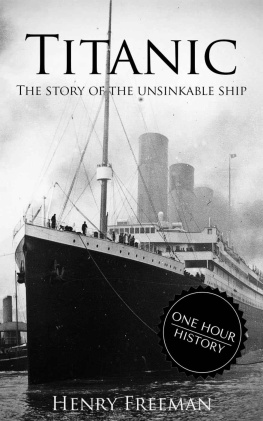
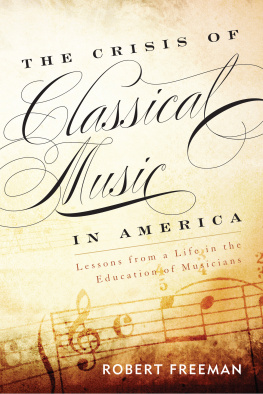

![Freeman - Pro design patterns in Swift: [learn how to apply classic design patterns to iOS app development using Swift]](/uploads/posts/book/201359/thumbs/freeman-pro-design-patterns-in-swift-learn-how.jpg)
